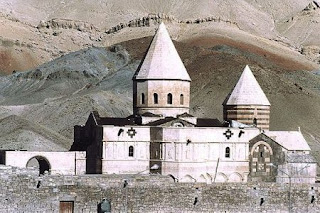Qara Kelisa
The St. Thaddeus Church best known as Qara Kelisa which literally means Black church is an ancient monument perched on a mountain ridge in the northern Iranian province of West Azarbaijan.
As one of the oldest and most notable surviving Christian monuments of Iran, Qara Kelisa carries great significance for the country's Armenian Orthodox community.
Armenians hold that Qara Kelisa is the world's first church and was constructed in 68 CE by one of the apostles of Jesus, Saint Thaddeus, who traveled to Armenia, then part of the Persian Empire, to preach the teachings of Christ.
Located south of the city of Maku, the massive church can be seen against the natural background of rolling hills; its cuspidate tambours catches the eye of beauty-seekers.
An ancient chapel two kilometers northwest of Qara Kelisa is said to have been the place where the first Christian woman, Sandokh, was martyred. The chapel is believed to be as old as the Black Church.
Throughout the course of history Qara Kelisa sustained damage and was repaired a number of times.
A large part of the monument was destroyed during the Mongol invasion in the 13th century. The Persian scientist Khajeh Nasir ad-Din Tousi oversaw its reconstruction during the reign of the Mongol ruler, Hulagu Khan.
Much of the existing structure dates back to the 19th century when the Qajar prince Abbas Mirza renovated the monument using carved sandstone.
Apart from the Armenian architectural elements visible in the structure of Qara Kelisa, another remarkable feature of the historical church is its spatial layout, which resembles that of the Echmiazin Cathedral in Armenia.
Every year scores of Armenians, Assyrians and Catholics from Iran and other countries visit the church to commemorate the martyrdom of Saint Thaddeus and his faithful followers.
The cruciform building is surmounted by two pyramidal shaped cupolas, the shorter of which has light and dark colored horizontal bands on the drum.
The church is composed of two parts: a black structure, the original building of the church and a white structure, the main church, which was added to the original building's western wing in 1810 CE.
The original church is a domed sanctuary built largely of dark-colored stone, probably dating to the tenth or eleventh century, from which its name Qara Kelisa is derived.
The main church, built in 1811-1820 is a massive structure, built of light sandstone and adorned with blind arches and decorative and geometric shapes.
Its twelve-sided tambour has been built in alternating light- and dark-colored stones and has an equal number of windows.
The church has two large courtyards, the first of which seems to have been used for agricultural purposes, while the second encircles the white structure, the portico, and a number of rooms.
The first courtyard includes oil-extracting rooms, a miniature windmill, an oven, and a fountain. It is decorated with ornamental motifs and two intricately designed stone crucifixes.
A small door opens to the second courtyard where the refectory and the kitchen along with rooms for resident monks and abbots are located.
The portico, which has been left unfinished, dates back to the mid 19th century.
The building's exterior is adorned with five rows of alternating dark and light stones as well as numerous round and blind arches, decorated with rosettes, coats-of-arms, flowers and animal figures.
Statues of angels adorn the front facade of the church and its northern and southern facades are decorated with dark-colored stone crucifixes.
Sculptured bas-reliefs bearing passages from the Old and New Testaments, mythical animals and effigies of saints have added to the beauty of the monument.
In the eastern part of the complex, there is a chapel and a sacristy hall. An Armenian inscription, carved on stone, gives an account of the construction of the buildings.
Another stone inscription can be seen on the front of the old portal, bearing the date when the monument was reconstructed by Abbas Mirza Qajar.
Qara Kelisa has been registered as the ninth Iranian historical-cultural heritage site on the United Nations Educational Scientific and Cultural Organization's (UNESCO) World Heritage List.
http://english.iribnews.ir/IranVision_body.aspx?ID=277

No comments:
Post a Comment